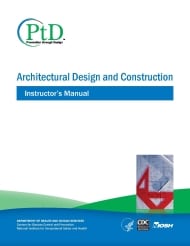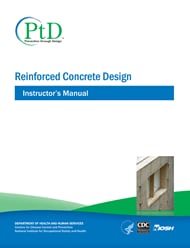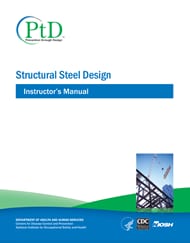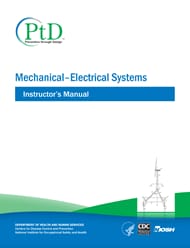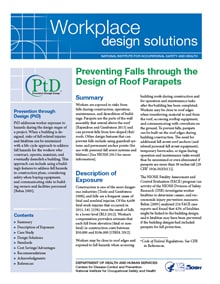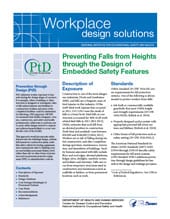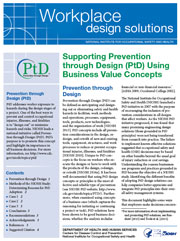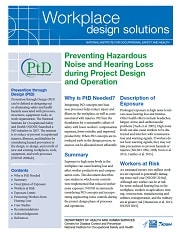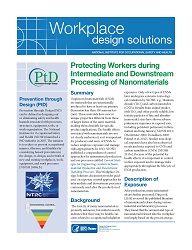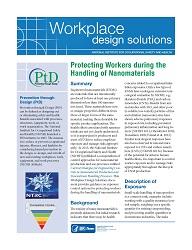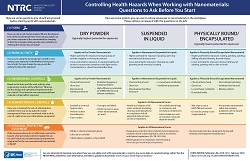Key points
Prevention through Design (PtD) resources and guidance to assist safety and health professionals, employers and employees implement prevention through design concepts in the workplace.
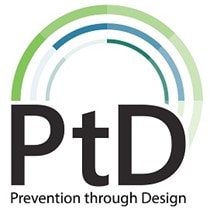
Training Materials
The PtD Program published four education modules to be used in undergraduate engineering classes. Each module consists of an Instructor’s Manual and a slide deck. Each module outlines the motivations for PtD, encourages inclusion of worker health and safety considerations early in the design process, and identifies hazards associated with the topic.
PtD FACE Reports
NIOSH Fatality Assessment and Control Evaluation (FACE) program includes design-related factors that have contributed to workplace fatalities and recommends appropriate design modifications. Both the NIOSH and State FACE reports on this page have special PtD links to see reports with design recommendations.
Workplace Design Solutions
Science Blog
The NIOSH Science Blog provides an opportunity to learn about various workplace safety and health topics and exchange ideas with leading researchers from NIOSH. View PtD-themed NIOSH Science Blogs.
NIOSHTIC-2 Database
See the NIOSHTIC-2 database search results on PtD NIOSHTIC-2 Search. NIOSHTIC-2 is a database of occupational safety and health publications funded in whole or in part by NIOSH.
Other Resources
ANSI/ASSP Z590.3 Prevention through Design consensus standard: This industry standard was a milestone for PtD progress, as it concisely summarized different aspects of PtD and provided risk management methods to follow, such as the collaborative Design Safety Review team. It is available from either the American National Standards Institute (ANSI) or the American Society of Safety Professionals (ASSP)
No-Cost tool for PtD and the Business Case: A practical risk management and business case tool was released by the AIHA. This no-cost tool helps think through and document a PtD risk management effort in line with the ANSI/ASSP Z590.3 standard, and then helps the users summarize a business case for their recommended intervention. The business case includes both financial and non-financial elements. AIHA developed this tool in collaboration with and with some funding from NIOSH.
Prevention through Design Initiative: The Arizona State University Ira A. Fulton Schools of Engineering coordinate and host annual PtD workshops with a wide range of success stories and helpful guidance for using PtD methods in the built environment. Examples show a wide range of benefits including benefits to the facility owner, the constructors, the end user/occupants, and the maintainers of the final facilities. The workshops are hosted in-person and virtually with presentations and summary reports available for no-cost viewing and downloading. The NIOSH Construction program funds this collaborative effort. Learn more on the initiative website.
Sustainability in the Workplace: OSHA has a long-term effort to encourage planning and prevention efforts that treat workers as the most precious limited resource.
Design for Safety: OSHA also provides guidance on designing for safety, to include the business case for doing so.
The OSHA Alliance Construction Roundtable Design for Construction Safety course and design solutions. Through the OSHA Alliance Program Construction Roundtable, participants developed a Design for Construction Safety website to provide information on PtD.
SliDeRulE for Buildings – a Design Comparison Tool: Based on answers to prompts, this site provides estimates of the safety profile for different building options such as steel versus concrete. See: www.constructionsliderule.org
PtD Credit for Green Building certifications: The U.S. Green Building Council's Leadership in Energy and Environmental Design, or LEED™ green building program, provides certification credit for using PtD methods. Resources include:
- Introductory Article
- The PtD Credit and downloadable worksheet guidance
- Webinars: Life Cycle Safety: Basics and Connections to Sustainability and LEED Pilot Credit Prevention through Design Background & Requirements
Safety and Chemical Engineering Education (SAChE) Program – Human Factors guidance: This program provides teaching materials and programs to bring elements of process safety into the education of undergraduate and graduate students studying chemical and biochemical products and processes. The ELA 981 course in Human Factors is notable in that it goes beyond chemical processes to incorporate lessons and principles focused on the day to day chemical worker's tasks.
The Purdue Process Safety and Assurance Center (P2SAC): P2SAC is an industry and academia partnership focused on designing out hazards in successful operations in the oil & gas, pharmaceutical, and technology industries.
International Resources
Prevention through Design is practiced actively across the world to benefit workers, designers, and owners.
United Kingdom
- Good Practice Lists
- Culture Change
- Design Risk Management
- Health and Safety in Construction
- Improving Health and Safety Outcomes in Construction – Making the Case for Building Information Modelling
- Improving Designers Knowledge of Hazards
Australia
Australian Safety and Compensation Council: The Australian Government's Safe Design Initiative. Safe Design is a process of hazard identification and risk assessment to eliminate or minimize risk of injury throughout the life of the product.

